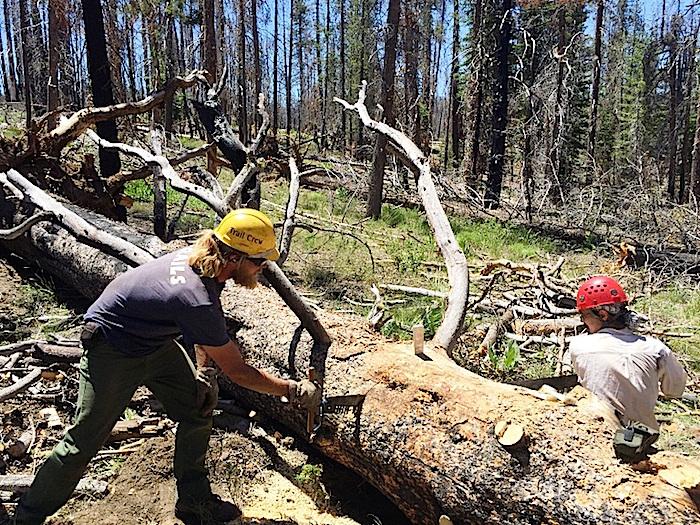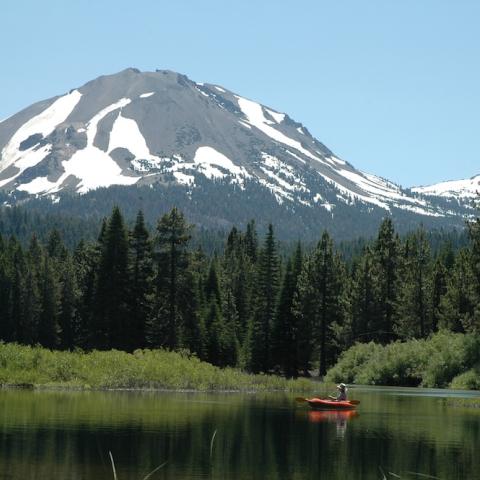
Since power tools are prohibited in officially designated wilderness, Lassen Volcanic trails worker Ben Darnell and PCTA volunteer Robert Parks used a freshly sharpened saw to clear a large lodgepole pine from a trail/NPS
Sometimes, you just need to resort to sweat and muscles to get the job done. That was the case recently in the wilderness backcountry of Lassen Volcanic National Park in California, where crews worked to clear trails of trees knocked down by a wind storm back in February.
Especially hard hit was an eight-mile stretch of the Pacific Crest Trail at Lassen’s northern boundary near Badger Flats and Soap Lake.
“This was an extremely productive project, which was safely accomplished through our partnership with the Pacific Crest Trail Association,” said Superintendent Steve Gibbons.
The PCT traverses about 17 miles of Lassen’s designated wilderness, necessitating the use of cross-cut saws to clear trails. Eight volunteer Pacific Crest Trail Association cross-cut sawyers worked with six members of Lassen’s trail crew for four days to buck out the downed trees along the trail. Crews cleared 368 trees from the park’s northern boundary to the Nobles Emigrant Trail junction with an additional 50 trees cleared south to the Rainbow Lake area. The 17-mile section of the PCT running through Lassen Volcanic National Park is now clear of fallen trees, in time for the influx of thru-hikers currently making their way from Mexico to Canada.
The project attracted some of the most skilled volunteers and cross-cut saw aficionados from across northern California due to the sheer number of trees that needed to be removed. The project was proof positive that no blow down event is too big for a team of cross-cut sawyers to handle efficiently and safely.
“We are fortunate to have a dedicated trail crew and willing volunteers with specialty cross cut saw training under their belts to help take care of our park,” said Gibbons.
For trail information, campground openings, and current conditions to plan your trip, please visit the park website at www.nps.gov/lavo or contact the visitor center at 530-595-4480 or [email protected].




 Support Essential Coverage of Essential Places
Support Essential Coverage of Essential Places







Comments
Hats off to the volunteers who performed all that hard work and sharpened all those saw teeth! Also to Lassen’s management for not taking the easy way out. The use of chainsaws for such work is more the rule than the exception in many western parks.
http://www.georgewright.org/283buono.pdf
Some might disagree with this story’s statement that “the project was proof positive that no blowdown event is too big for a team of cross-cut sawyers to handle efficiently and safely.” At NW parks, especially Olympic, strong windstorms can leave hundreds of trees up to six feet in diameter stacked three high on top of each other, often on steep slopes. The oldtimers didn’t bother with crosscuts for such blowdowns. It was easier and safer to drill holes with a large hand auger and dynamite the trails clear. .
"Also to Lassen's management for not taking the easy way out."
God forbid we get 2-3x as much accomplished using the right tools. Banning chainsaws for trail work makes as much sense as banning bicycles.